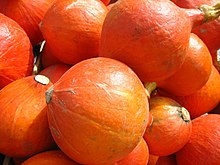Hokkaido pumpkin
Hokkaido pumpkins are round, orange-red edible pumpkins of the species Cucurbita maxima with a weight of about 0.5 to 1.5 kilograms, with an approximate density of 730 kilograms per cubic meter, whose thin skin, unlike most other pumpkin varieties, softens when cooked and can be consumed. The pulp has a nutty aroma, similar to chestnuts , and a stable consistency, although it contains hardly any fibers.
use
This type of pumpkin adapts to many flavors, but harmonizes particularly well with ginger and chilli and can be used in many ways for soups, casseroles or as vegetables. The Hokkaido pumpkin can also be eaten raw or used in salads.
The kernels of Hokkaido are dried. Then you can sow or eat them. The thickness of the core shell can vary, which means that the kernels are not always tasty.
| Nutritional values per 100 g of pumpkin | ||
|---|---|---|
| energy | 264 kJ (= 63 kcal ) | |
| protein | 1.7 g | |
| fat | 0.6 g | |
| carbohydrates | 12.6 g | |
| Fiber | 2.5 g | |
| vitamin C | 32.1 mg | |
history
Pumpkins were brought to Japan by the Portuguese as early as the 16th century, where they spread across Japan from Nagasaki . In the 19th century, new types of squash from America were added - including in 1878 by US agricultural consultants hitherto unknown in Japan, hard and low-flavor Pumpkin type Hubbard , from the on Hokkaido of Pumpkin, variety Kuri aji ( Jap. 栗味 , dt. "Chestnut flavor") and from this in turn in Aizu (today in the Fukushima prefecture ) the new pumpkin variety Aizu-kuri-kabocha ( 会 津 赤 川 甘 栗 か ぼ ち ゃ ) was bred.
In Kanazawa ( Ishikawa Prefecture ), the vegetable farmer Saichirō Matsumoto ( 松本 佐 一郎 ) from Utsugi-machi ( 打 木 町 - the name Uchiki comes from the place name Utsugi ) then tried for years to grow even better pumpkins from this variety, which he finally did in 1933 with the The current Uchiki kuri (Hokkaido pumpkin ) variety was ready for the market .
The variety Uchiki kuri or Utsugi-akagawa-amaguri-kabocha ( akagawa = red peel, amaguri = sweet chestnut , kabocha = pumpkin) has also been known in specialist circles. How it finally came to be called Hokkaido is unknown.
Hokkaido pumpkins have also been grown in Europe since the 1990s and are regularly available in stores.
In Japan, Hokkaido pumpkins belong to the Kaga vegetable , traditional vegetables from Kaga , the old name of Ishikawa.
Cultivation and storage
Hokkaido is often preferred in the greenhouse or on a window sill, and then planted outdoors after the last expected late frosts. However, both larger and smaller fruits can be beneficial, depending on the specific needs of the consumer (cut Hokkaidos lose their shelf life).
Hokkaido can be harvested from September to December. Unlike many typical stored vegetables , pumpkins are sensitive to frost and should be stored at 10 to 15 ° C. Undamaged pumpkins with an intact stem base keep for several months.
literature
- Brigitte Schöner, Hans Streicher: Pumpkin. Grow, prepare and decorate the best varieties. 3. Edition. BLV Buchverlag, Munich 2005, ISBN 3-405-16968-2 .
Web links
Individual evidence
- ↑ Plant Database / Winter Squash 'Uchiki Kuri' . Folia website by Nathan Hawes & Nicole Pascoe. Retrieved April 13, 2015.
- ↑ Effect of different stand widths on the yield of Hokkaido pumpkin in organic farming. State Research Center for Agriculture and Fisheries Mecklenburg-Western Pomerania, accessed on August 21, 2019 .
- ↑ Hokkaido Pumpkin Seeds' Uchiki Kuri. Retrieved August 21, 2019 .
- ↑ Summary of the history and description of Hokkaido pumpkin or Uchiki kuri on the HP of Kanazawa City Agricultural Association of Name-Brand 打 木 赤 皮 甘 栗 か ぼ ち ゃ ( Memento from April 24, 2015 in the Internet Archive ). In: Kanazawa City Agricultural Association of Name-Brand. Top Page> Kaga-Yasai ni tsuite (about Kaga-Yasai)> Utsugi (> Uchiki) -Akagawa-Amaguri-Kabocha 打 木 赤 皮 甘 栗 か ぼ ち ゃ . Retrieved April 13, 2015 (Japanese).
- ↑ Süddeutsche Zeitung Magazin: H - Hokkaido pumpkin. Retrieved April 4, 2011.
- ↑ Nadia Hassani: The alpha squash. Retrieved January 5, 2015.
- ↑ So-called Hokkaido pumpkin, Utsugi-Akagawa-Amaguri-Kabocha (Uchiki kuri), belongs to the tradition of Kaga-Yasai, kaga vegetables. Uchiki kuri as Kaga-Yasai on Shizenjin.net 打 木 赤 皮 甘 栗 か ぼ ち ゃ (加 賀 野菜) う う つ ぎ あ か が わ あ ま ぐ り か ぼ ち ゃ . In: 打 木 赤 皮 甘 栗 か ぼ ち ゃ (加 賀 野菜) う つ ぎ あ か が わ わ あ ま ぐ り か ぼ ち ゃ. Utsugi (= Uchiki) Akagawa Amaguri Kabocha (Kaga-Yasai). Retrieved April 13, 2015.



